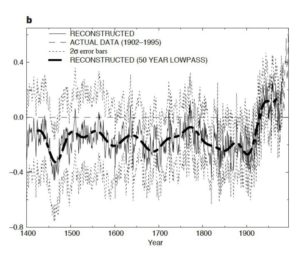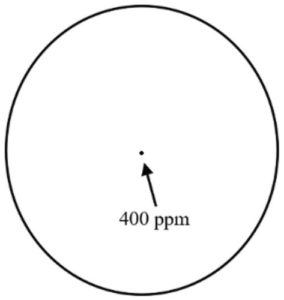by J. Curry and N. Lewis, April 24, 2018 in ClimateAudit
There has been considerable scientific investigation of the magnitude of the warming of Earth’s climate by changes in atmospheric carbon dioxide (CO2) concentration. Two standard metrics summarize the sensitivity of global surface temperature to an externally imposed radiative forcing. Equilibrium climate sensitivity (ECS) represents the equilibrium change in surface temperature to a doubling of atmospheric CO2 concentration. Transient climate response (TCR), a shorter-term measure over 70 years, represents warming at the time CO2 concentration has doubled when it is increased by 1% a year.
(…)
See also here
by Anthony Watts, April 23, 2018 in WUWT
Twenty years ago today: The infamous “hockey stick” graph that crystalized global warming and ignited the climate wars was published, and became known as MBH98. The science in it was so bad, it is credited with spawning the modern climate skeptic movement.

Original “hockey stick” temperature graph in Nature, 1998. The Y axis shows the Northern hemisphere mean temperature, in degrees Celsius; the zero line corresponds to the 1902 – 1980 mean. Credit: “Global-scale Temperature Patterns and Climate Forcing over the Past Six Centuries,” by Michael E. Mann et al. in Nature, Vol. 392, April 23, 1998
by Polar Bear Science, April 21, 2018
New evidence from clams and mussels with temperature-sensitive habitat requirements confirm that warmer temperatures and less sea ice than today existed during the early Holocene period about 10.2–9.2 thousand years ago and between 8.2 and 6.0 thousand years ago (based on radio carbon dates) around Svalbard. Barents Sea polar bears almost certainly survived those previous low-ice periods, as they are doing today, by staying close to the Franz Josef Land Archipelago in the eastern half of the region where sea ice is more persistent (…)
See also CBC.news
by A. Stewart, April 23, 2018 in ClimateChangeDispatch
Could someone explain in 100 words or less without complex algebraic formulas how the trace gases, approximately 1% of the atmosphere can overtly control the temperatures of the remaining 99% atmospheric constituents?

by Donna Laframboise, April 23, 2018 in ClimateChangeDispatch
SPOTLIGHT: After the Intergovernmental Panel on Climate Change (IPCC) report was released in 2007, its dramatic findings of species extinction were repeatedly emphasized by chairman Rajendra Pachauri.
BIG PICTURE: When it examined the question of species extinction, the 2007 IPCC report relied heavily on a single piece of research – a Nature cover storypublished early in 2004. Written by Chris Thomas and 18 others, this was the source of Pachauri’s claim that climate change threatened 20 to 30% of the world’s species.
La géologie, une science plus que passionnante … et diverse


